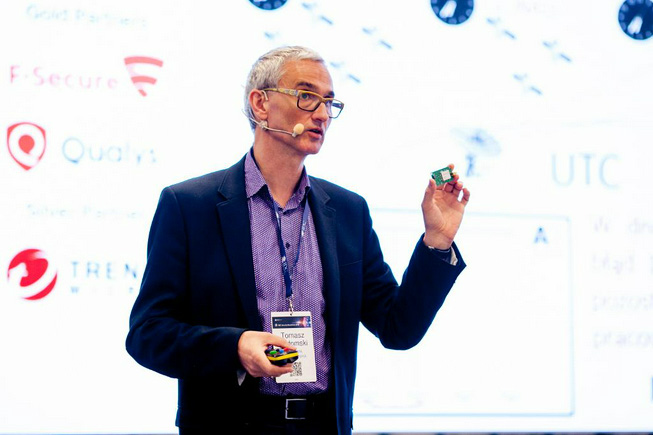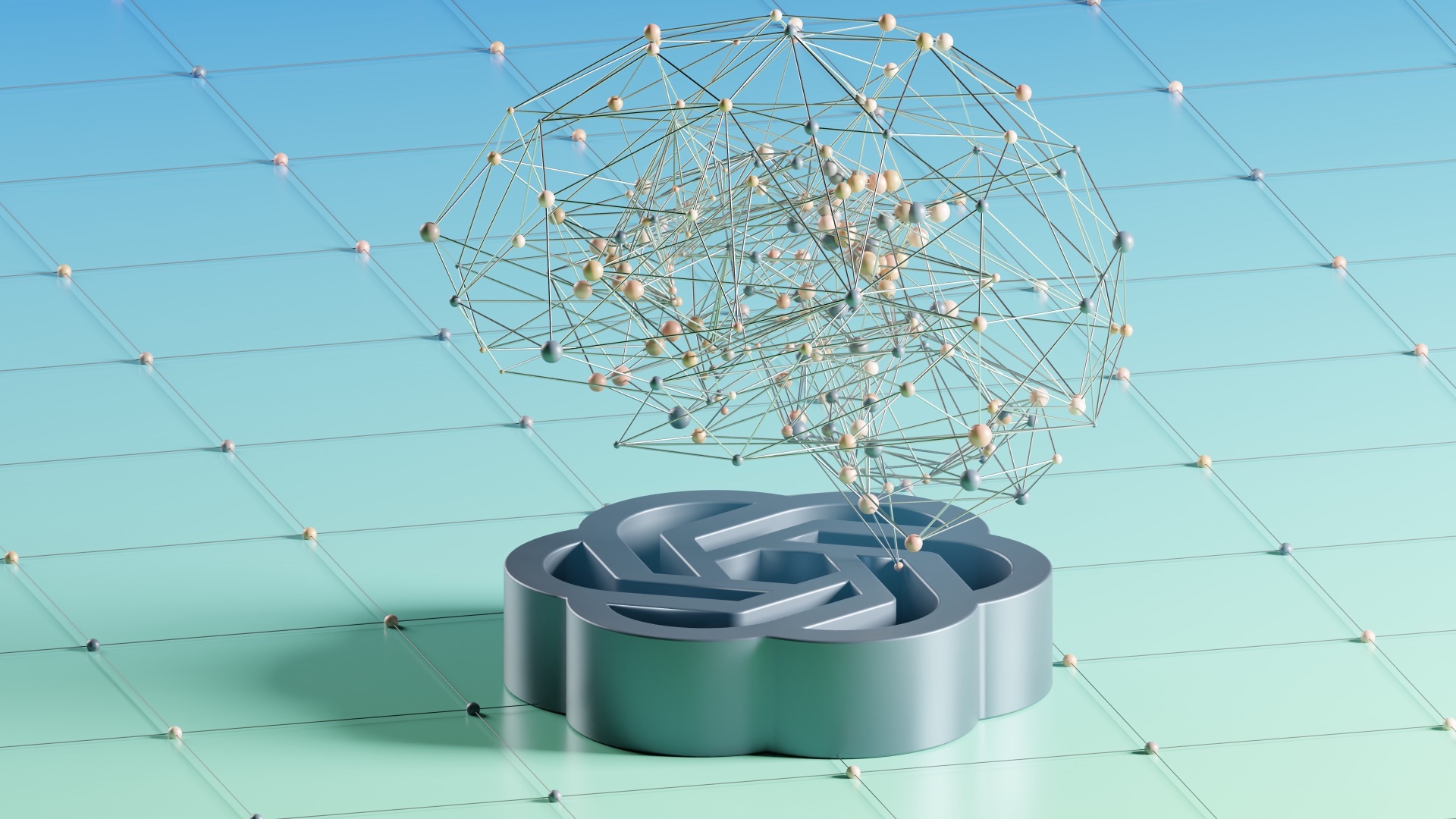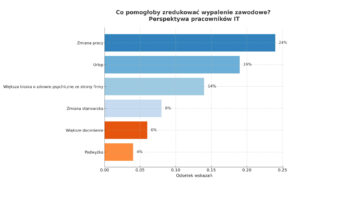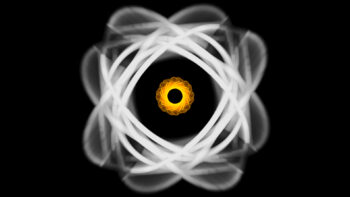The transformation of the Polish power sector is accelerating, driven by the growing share of renewable energy sources and the need to modernise transmission infrastructure. More and more companies and prosumers are investing in RES, but the massive growth of decentralised sources raises serious challenges for the traditionally unidirectional electricity grid. We talk to Tomasz Widomski of Elproma – an expert in telemetry, synchronisation and critical infrastructure security – about why the construction of smart grids is crucial for Poland’s energy security today, the role of time synchronisation in modern infrastructure and what barriers still stand in the way of full transformation.
Klaudia Ciesielska, Brandsit: Energy is a very hot topic lately. Rising energy prices have led more and more people and companies to opt for RES solutions. What are the technological challenges for the Polish power grid posed by such an increase in the number of energy prosumers?
Tomasz Widomski, Elproma: At the moment, the biggest technological challenge is the urgent deployment of smart two-way smart grids. This is a multi-year investment process, very complex to implement, but it is absolutely essential for our country. Without a smart grid, it will not be possible to integrate highly distributed RES into the power grid, which needs to remain scalable, it needs to give the opportunity for further expansion. This is what all prosumers and RES investors in Poland care about. Moreover, without the transformation to a smart grid, it will not be possible to effectively combine in one grid, fossil fuel-based energy, RES, nuclear energy, which we are planning. The challenge has become how to combine all this, how to ensure scalability and even distribution of the energy produced in so many places, how to provide it evenly to all consumers, how to optimise distribution routes to make them as short as possible, etc. How to organise these processes so that there are no surpluses as well as shortages of energy. I will explain this with a simple comparison.
The problem of over-distributed energy by traction can be most simply illustrated by comparing it to road transport on a one-way main road, as the current energy supply is precisely one-way and operates in the direction from the power station to the consumer. An arbitrarily large number of cars arriving via side roads cannot be diverted onto such a road (the arrivals represent RES energy) because they will block traffic on the main road, and this will trigger special safeguards, stopping all traffic. The traffic will then stop and this means an interruption in the delivery of people who are late for work. Such an interruption therefore always results in financial losses. In the classic power plant we use, distribution priority is always given to large power plants. They have to work, they cannot be stopped, so they have to have a higher priority than RES to use the transmission grid. In this case, RES are shut down, their production and access to energy supply is limited, etc.
In contrast, the under-distribution of energy can be compared to having to borrow cars from other, independent roads, because they have to be diverted onto our main road so that traffic does not die on it and a minimum number of people can be brought to work on time. Let us agree that traffic will reduce everywhere, both on the main road (this is where the borrowed cars go) and on other parallel roads from where the cars have been borrowed. The important condition is that on none of the roads, both the main road and the other roads, does the frequency of cars driving fall below a certain minimum (some minimum traffic must remain). If the frequency of cars driving on the road drops to an alarming minimum, the safety devices will again be triggered and traffic will be stopped.
In the smart grid, we are facing a civilisational change to the entire system of electricity distribution and transport management. To use an earlier comparison, we are facing the construction of a new road system that allows two-way traffic. Access roads, turnouts and collision-free crossings will be needed. Access shortcuts and banding of main connecting roads will need to be created. All of this must be built so that transport always takes the shortest route and without destroying the existing distribution network.
The challenge, therefore, is to plan the energy transition process and carry it out safely so that the country moves from a one-way energy (as we have today) to a two-way programmable energy.
“At the moment, the biggest technological challenge is the urgent deployment of smart two-way smart grids. This is a multi-year investment process, very complex to implement, but it is absolutely essential for our country.”
K. C.: In one of your conversations with our Editorial Board you stated that Polish networks face the challenge of transformation to distributed networks. At that time you drew attention to the problems related to the need for synchronisation. Two years have passed since then. What changes have you observed in this regard in the Polish energy sector? Has anything changed?
T. W.: In the last two years, the Polish energy sector has made progress in smart-metering smart-reading implementations, but we still face the main challenge of building smart grids. Automated reading is a preliminary stage and always comes before the construction of the essential smart-grid. We often mistakenly believe that smart-metering and smart-grid are not related. This is not true. What we most often do not realise is that the automation of smart-metering readings gives a great deal of important information used in the future smart-grid. In initial deployments, smart-metering boils down to the automation of the billing process. For such purposes, synchronisation is specifically needed. For smart-metering understood in this way, the role of official time standards is more important. Time, like units of other measurements, including the volt, the metre or the kilogram, are subject to state supervision. And like time – they must be standardised. Poland has a law defining official time standards. The use of incorrect time in the measurement of energy consumption (kWh) has a consequent financial loss. The Polish UTC(PL) time standard is supervised by the Central Office of Measures. The Polish UTC(PL) scale is currently one of the best in the world. The national atomic standards from GUM have a very high weight (quality factor) in the group of all atomic clocks in the world, which are supervised by the International Bureau of Weights and Measures BIPM in Sevres near Paris.
Automated smart-metering readings, used for billing needs, do not have to be performed frequently. Automated reading is increasingly replacing the work of the bill collector. On the other hand, the moment smart-metering is used as smart-grid support, the situation becomes completely different.
Here, the importance of synchronisation increases with the extension of smart-metering to include functions for the ongoing reporting of energy consumption to the smart-grid management system. Real-time tracking of meter status makes it possible to create short-term demand trends and, on the basis of these, very accurately predict the consumption that is about to occur. This is a whole new dimension of forecasting, allowing the smart-grid system to manage electricity production and distribution more effectively. The management system also ensures that the path from energy generation to the consumer is always as short as possible. This minimises transmission losses and so ultimately also lowers the price of electricity, which in addition is only generated in the amount that can be received and consumed. Energy transmitted over long distances is largely irretrievably lost as so-called reactive power. It cannot be used, but you have to pay for its generation. The price of useless reactive power is automatically included in our bills and we have no influence over it. A well-synchronised smart grid will keep electricity prices as low as possible by optimising production and distribution.
Synchronisation is also used for diagnostic testing of the traction itself. It makes it possible to pinpoint failure-prone areas with a high degree of accuracy even before they occur. This is investigated by injecting a special test pulse into the traction and measuring the precise timing and characteristics of the traction response. In this way, both the location of the failure prone area and the type of degradation of the traction itself are obtained with a high degree of accuracy. Further repair, of course, requires human intervention.
“With a well-synchronised smart grid, electricity prices will be the lowest possible by optimising production and distribution.”
It is difficult to add new RES sources in large quantities to the classic unidirectional energy distribution network. This is because the power industry likes neither surplus nor shortage of energy. As energy transmission has technical limitations, priority access is always given to classic power plants whose production units cannot be stopped. Both overproduction of energy and underproduction of energy are very bad – even dangerous, and can lead to serious breakdowns, including blackouts. Every power outage brings a financial loss, but a blackout is a particularly dangerous social phenomenon and always leaves a loss visible in a country’s GDP. This is what everyone fears, as a long-term power shortage has far-reaching consequences both economically and socially, posing a real threat to economic stability in the region and even the state.
In contrast to the classic one-way distribution, in the smart grid electricity is transmitted in both directions and these can change dynamically. Principles similar to how information flows on the Internet begin to apply, but electricity will flow in both directions alongside the information. It will not flow simultaneously, but will be switched by the Wide Area Monitoring System (WAMS). In this way, connections can also be established that bypass traction failure points. With the WAMS management system, flow routes can be optimised by switching on/off/reducing RES production. Thanks to special ‘soft’ traction switching, connections are implemented unobtrusively and the unit price of the energy thus supplied should be the lowest. This is because the smart grid balances energy production with consumption and does so always on an ongoing basis. It establishes a balanced production corresponding to the current demand of all grid consumers. Thanks to smart-metering smart readings, the system knows these needs very well. However, that is not all.
Special distributed PMU (Phasor Measurement Unit) sensors equipped with local clocks are used to assess the energy status of a large region on an ongoing basis. These have to be very precisely synchronised with an accuracy of 1μs, as the control measurements are time-stamped and transmitted to the central WAMS system. The monitoring assumes that the information remaining after filtering the PMU data (e.g. data arriving with an unacceptable delay is sifted out) reflects with high probability the actual energy state of the entire region. Only such data are considered and taken into account together with forecasting information from smart-metering. Based on the data, the central WAMS management system forecasts the situation for the next moment in the future by issuing traction control instructions to special IEDs (Intelligent Electronic Device). This is how the time-varying, dynamic structure of energy transmission in the smart grid is created, the stability of which particularly depends precisely on accurate timing and synchronisation.
Inside the smart grid backbone infrastructure, synchronisation of PMUs and IEDs is critical.To ensure an accurate common time domain across the country, advanced satellite and network technologies are needed. Poland has such solutions at its disposal, and companies such as Elproma (www.elpromatime.com , www.teleorigin.com) have many years of practical experience of telemetry and synchronisation deployments to state-of-the-art smart grid infrastructures in Asia – the continent that is by far the fastest to implement the smart grid.
The transformation to a smart grid is a multi-year process, takes several decades, and requires a hierarchy of implementations, as not everything can be achieved in one step. Some experiments of so-called soft IED switching are already underway in Poland with the participation of some operators. Certainly, it is very important that this mechanism works very smoothly between energy operators. This has a great impact on improving the energy security of the whole country.
K. C.: You recently mentioned that you have updated a report for national institutions on the smart grid issue. What does the update contain? What is the reason for its need?
T. W.:The updates relate to a feasibility study for the construction of a smart grid. The project must take into account the latest cyber security paradigm shifts in the new geopolitical realities. This is essential for the stability of the smart grid backbone infrastructure. Here, the catalyst for all devices is precise timing and synchronisation. Today we know more than we did two years ago about how to build such a secure foundation for a smart grid backbone infrastructure, where to start, how to group tasks, how to stagger work, which ones can be paralleled, how much it costs, etc. This is invaluable knowledge based on experience from projects we have carried out before around the world.
Elproma has unique practical experience of smart grid synchronisation on a very large scale. This is mainly thanks to our participation in the DEMETRA Horizon 2020 project, where we received very high marks from experts. We now know that precise synchronisation is fundamental to the stability and cyber security of a highly distributed smart grid. We understand what the ‘Time Synchronisation Attack’ is on the new generation of PMU Synchrophasors, which require synchronisation compliance of less than 1μs. We are able to prevent this. The participation of our experts in international forums on this difficult issue today gives us the tools and the necessary engineering background. – The participation of Elproma’s experts in the work of DG Energy (2017-2018), or the recent accredited participation in ITU-R WP-7A level meetings (2020-2023). It is worth noting that the Polish delegation provided an important contribution to the stability of the smart grid from ITU-R WP-7A, a group that works directly with the UN in Geneva. Polish experts flawlessly identified, pointed out and described the risks posed by the so-called discontinuity of the UTC time scale for the smart grid and Industry 4.0 as a whole, i.e. the problem of handling leap seconds.
The work of the Poles was very much appreciated by the delegations of other countries. For the first time in the 100-year history of the ITU, the Polish voice was not only heard, but also played a significant role in changes to ITU recommendations. A Polish publication describing the contribution of the NPRM delegation will soon be published in ITU-News. A summary of Poland’s contribution to the ITU can be found on the PTI and PIIT websites .
“For the first time in the 100-year history of the ITU, the Polish voice was not only heard, but also played a significant role in changes to ITU recommendations.”
Back to synchronisation. Synchrophasors, as the name implies, need to synchronously (simultaneously) measure phase at multiple remote locations in a distributed smart grid.
This is why secure and accurate synchronisation is so important, and why its disruption is a significant threat to cyber security. Synchronisation in the smart grid is a very important part of the backbone infrastructure and must be well designed from the very beginning. It also represents a visible percentage of smart grid backbone investment. Obtaining a stable supply of a common UTC time standard over such a large area of the country is a technically very difficult task, because it is not enough here to simply use simple GPS or other GNSS systems.
Attacks on smart grid PMU synchrophasors are carried out using special devices for jamming GNSS signals (jamming) and for spoofing satellite signals (GPS spoofing). This is far simpler than hacking into internal energy systems. It is on these issues that we update the data in the reports. A lot of experience is also exchanged between us and other companies in the industry, including those with whom we compete on a daily basis.
K. C.: What barriers do you see when it comes to the development of smart grids in Poland?
T. W.: It is necessary to improve public awareness of what a smart grid is and to gain public acceptance and support for its construction. Without a smart grid, electric cars and even more so hydrogen vehicles will not be developed on a mass scale, because the production of hydrogen on a mass scale depends on the low price of electricity and the dispersion of its sources, a condition that only a smart grid can meet. However, this is the least of the problems. Unfortunately, without a smart grid, electricity prices will continue to rise, power failures and outages will increase. This will be reflected in the country’s GDP. We will not develop at the rate we could. As a consequence – Poland will reduce its international competitiveness. This, in turn, will have an impact on investments, jobs, and thus generally on the standard of living in our country. It is therefore important to break the wrong stereotypes of thinking, the fear of innovation, also before, in a sense, the experiment that the energy transformation to smart grid brings.
“We need to start with a better public understanding that RES is not a smart grid – only part of it, but without a smart grid you cannot attach large numbers of new RES to the transmission grid.”
We need to start with a better public understanding that RES is not a smart grid – only a part of it, but without a smart grid you cannot attach large numbers of new RES to the transmission grid. It is also high time not to confuse smart metering with smart grid. In Poland, we have a very well-developed smart-metering, but only in the profile of automation of meter reading for billing purposes.
What is needed now is to extend smart-metering with new functions for continuous ongoing monitoring of readings, which will provide information to the future smart grid about the current trend of energy consumption. This is realised with the help of M2M telemetry, and such an extension process can be efficiently carried out in Poland today. Extended smart-metering will allow the WAMS system to control electricity production to match current market demand.
“It is high time not to confuse smart metering with smart grid. In Poland we have a very well-developing smart-metering, but only in the profile of automating meter reading for billing purposes.”
In the case of RES, it is very easy to impose restrictions on energy production, while in classic power generation it is impossible to stop the turbine producing energy. Understanding this should convince you that balancing distributed scalable RES production in proportion to its current demand results in very large financial savings – we only pay for the energy that is produced and consumed. If we add the issue of optimal distribution management so as to minimise the path from energy generation to consumption, we just hold the recipe for lowering electricity prices, and it does not matter what it is generated from.
Backup energy storage centres are another barrier. They are needed to counteract the effects of failures and to balance distribution. There is a lot of talk today about stations based on chemical cells. These are very efficient, but also environmentally unfriendly in terms of subsequent disposal. There is less mention of the possibilities offered by the Earth’s natural gravity. To realise a gravitational electricity bank, cranes and heavy conversion blocks are needed. Whenever we want to conserve excess energy generated in smart grids, we have a crane lift a block from the ground and pile it high on top of others. By lifting the block up, the crane performs work against the force of gravity and, in doing so, consumes energy itself. This energy is not lost irretrievably and most of it remains accumulated in the block, which is now located high up. When we want to recover the energy and produce electricity, the block is then lowered automatically, which drives a generator and generates (recovers) electricity by gravity. In this way, electricity can be stored on a very long-term basis. Yet another method of storing electricity in the smart grid is through electric cars. It turns out that although they themselves require a fast-charging station, they can allocate several per cent of the energy so charged to others, acting as a mobile powerbank and transporting electricity from place to place. Of course, for this process to have an industrial-scale dimension, there must be a sufficient number of electric vehicles on the market – these in turn require a smart grid for the organisation of the fast-charging system and so on.
K. C.: What impact does the war situation in Ukraine have on our energy networks?
T. W.: Poland, like other countries in the region, is learning from the events in Ukraine. The deliberate destruction of energy infrastructure has become an element of war. In a way, it is precisely such experiences that teach us that the power industry should be distributed, with many independent diverse sources of electricity generation, and a two-way distribution system to bypass the sites of damage caused by war.
But it is not only war that is being experienced. A few years earlier, we observed smart grid deployments in selected countries in Asia. We noted that many countries were implementing smart grids to counteract power outages caused by earthquakes, volcanic destruction, the elements such as hurricanes, the effects of tsunamis and so on. The nature of the two-way power transmission of the smart grid allows for the creation of routing as we know it from data transmission on the internet, it allows for the rerouting of power transmission to other routes and bypasses. This is a very pragmatic approach that strengthens the country’s energy security.
“In a sense, it is experiences like this that teach that power generation should be distributed, with multiple independent diverse sources of electricity generation, and a bi-directional distribution system to avoid war damage sites.”
This is why smart grids are often invested in by countries that are less wealthy and just developing their energy sector, i.e. countries where not all citizens have access to electricity. These are countries in Asia, selected African and South American countries. It is likely that Ukraine will take a similar path after the war to rebuild its infrastructure. Polish Power Grid and operators already have a lot of experience in M2M telemetry and smart-metering, so they could share such experience with Ukraine in the future, which would be beneficial for the development of both economies and regional cooperation.
K. C.: How would you assess the overall level of cyber security of our energy networks? What factors does it depend on?
T. W.: It depends on how you define threat vectors. On the one hand, definitely the old type of current energy is less vulnerable to the latest threat of destabilisation through unsynchronisation. Threats such as Time Synchronisation Attack are particularly threatening to the new smart grid. On the other hand, the smart grid’s well-structured time synchronisation foundation provides it with a high degree of resilience against attack, and the distributed architecture diversifies the risks that centralised energy production and distribution have. Someone could say “the stick has two ends”, but definitely the experience of other countries shows that there is no escaping from the smart grid and the challenge of its implementation must be faced. For other, more classic types of cyber threats to the energy sector, ask the sector’s cyber security experts.
When it comes to the possibility of time manipulation, Elproma has long collaborated and exchanged experiences with other industry players around the world. This is very well illustrated by the example of the joint petition addressed by Elproma in 2022 together with the OCP-TAP group (the group leader is Facebook and can be found here all IT companies such as Google, Microsoft, AWS, Intel, NVIDIA, Oracle, SAP and many others) in the form of a letter that we addressed directly to the ITU-R Director himself – Mr Mario Maniewicz. The reported problem was discussed during the ITU meetings (WP-7A group) in Geneva at the UN in 2021-2022, and became the subject of our country’s first ever ITU contribution, as I mentioned earlier in this interview.
One of the less market-noticed preventive measures to improve cyber security that Poland has taken on its own is the construction of a system to distribute Polish official time via the Internet and 225kHz radio network from Solec Kujawski. The project, called eCzasPL, is led by the Central Office of Measures of the Republic of Poland. It will provide official Polish time to all critical infrastructures in the future, including, hopefully, the smart grid energy sector.
K. C.: Let’s go back to time synchronisation. Why how is it so important for other critical infrastructures?
T. W.: Synchronisation is needed wherever there is a distributed architecture, and this is the architecture of every critical infrastructure today, not just smart grid energy. 5G telecommunications infrastructure is distributed, the cloud to which industry is gradually migrating is distributed.
By its very nature, distributed is the whole of Industry 4.0, to which the global economy is evolving and all of which requires synchronisation. Here, time acts as conductor of an orchestra of entire systems that are remote but interdependent. In such an architecture, we are dealing with Time Coordinated Computing and many of the measurement and control elements must operate in real time – and therefore on the fly and with minimal latency (low-latency networking). Technology is increasingly applying Machine Learning (ML) and Artifical Intelligence (AI) in time-dependent decision-making. We see this very much everywhere where management based on a predictive mechanism for anticipating the next moments of the entire infrastructure, adapting control to the forecast, is emerging.
“Time here acts as conductor of an orchestra of entire systems that are remote but interdependent.”
By moving the management of critical infrastructures to the network and the cloud, we have simultaneously changed the cyber security paradigm. A few years ago, the world understood that today’s cyber threats would focus on trying to destabilise the operation of entire critical infrastructures. It turns out that instead of breaking ciphers and hacking into the internal network, it is simpler to destabilise it by disrupting precisely the synchronisation and timing in the increasingly distributed architecture of critical infrastructures. In addition, by manipulating time, the chronology of events recorded in LOG logs can be disrupted. The opportunity to analyse errors and determine the cause of failures or intentional attacks is then irretrievably lost. Today, perceptions of cyber security are changing, with hacker attacks of the ‘time synchronisation attack’ and ‘time delay attack’ classes being among the most likely and most dangerous to the highly automated and GPS-dependent economy of any developing country.
Elproma’s Polish servers are recognised internationally and exemplify a modern approach in IT and OT cyber security, including energy. To a large extent, our country creates the global synchronisation market and we have great achievements here. It is worth mentioning the White Rabbit CERN project, which was created by two Polish engineers from the Warsaw University of Technology, one of whom worked for many years at Elprom. Today, Elprom’s proposed standard of interchangeable GNSS modules has been picked up and applied to CLOUD solutions from Facebook and other OCP-TAP members. It is also worth noting that Elproma’s servers received NATO codification last year and are used by several armies of NATO armed forces in Europe. It is important that Polish products used in NATO can be used while supporting the security of critical infrastructures, including the smart grid.
“Today’s cyber threats will focus on attempts to destabilise the operation of entire critical infrastructures by disrupting precisely synchronisation and timing.”
K. C.: As Elproma, you have been dealing with the problem of time synchronisation in critical infrastructures around the world for many years. What has been the approach to this subject over the years in Poland and around the world?
T. W.: Poland does not belong to the avant-garde group of pioneers in the implementation of the latest IT technologies. As a country, we represent a more balanced model of implementing the latest technologies, which most often arrive imported from abroad. That is why selling Elproma servers in Poland has never been and is not easy. We still remain a company with more than 90% export of our own products. I would say that companies like Elproma have, for thirty years of existence in the free market, with consistency and patience, built a Polish brand that is also a showcase of Polish technical thought in the world. However, we also have very large deployments to critical infrastructures in Poland. For example, in 2008, Elproma implemented a very pioneering, for the time, large-scale synchronisation system at the Polish Air Traffic Agency. To this day, this system is a reference model used by other countries. At the beginning of 2023, so even 15 years after its implementation at the Polish Air Traffic Agency, we received very nice information about the selection of our project and equipment for the air traffic management system by a country considered to be one of the world leaders in the cyber security segment. This is an honour for us, but also a very big challenge that I hope we will handle exemplarily.
The eCzasPL project of the Central Office of Weights and Measures is certainly worthy of mention. It is the third in the world, after the American NIST and the British NPL, a system for distributing official time by fibre optics, intended to create a redundant alternative to GNSS satellite patterns. It is hoped that the eCasPL solution will improve the security and stability of all national critical infrastructures, IT in public administration and national business.
Tomasz Widomski (ELPROMA), graduate in computer science from the Warsaw University of Technology. He completed postgraduate studies at the Warsaw School of Economics. Entrepreneur, founder and first President of the Management Board of ELPROMA for many years – currently a member of its Supervisory Board. He sits on the supervisory boards of WSE listed companies. Co-founded the ELPROMA-TIME brand producing world-renowned Polish time servers. He led the Polish team in CERN White Rabbit, GSA DEMETRA Horizon2020 projects, where a terrestrial official time distribution service for Industry4.0 and modern TSN networks was created. Participant in the GIANO Horizon2020 project for the construction of the first European GALILEO time receiver with cryptographic anti-spoofing authentication broadcast from satellites. Serves as national consultant on time metrology to the Central Office of Weights and Measures of the Republic of Poland. He has advised the cybersecurity working teams of the DG-ENERGY and DG-CONNECT groups for the European Commission. As a participant in OCP (Open Computer Project) groups, he advised experts from Facebook and NVIDIA. He specialises in the narrow area of cyber-security related to the synchronisation of critical infrastructures: quantum cryptography QKD, distributed energy smart-grids, 5G telecommunications, automated financial sector HFT and Industry 4.0.












